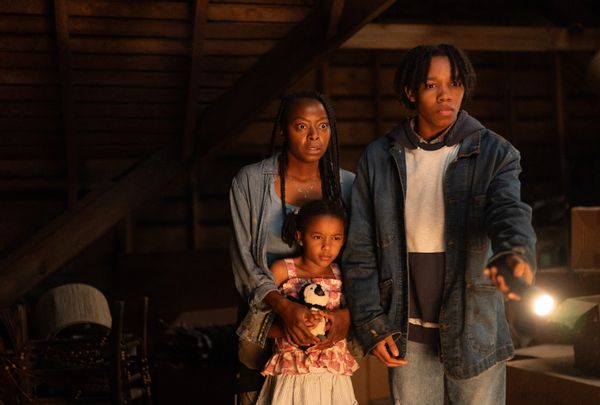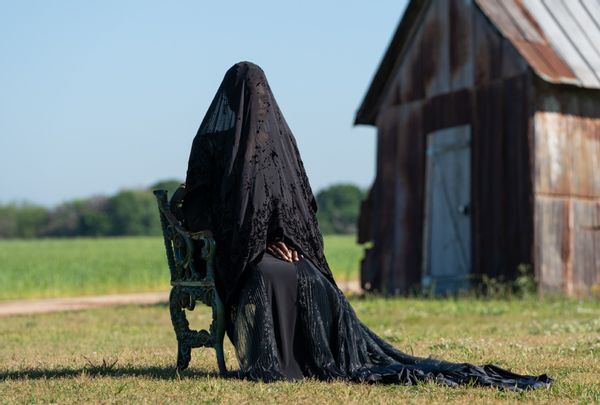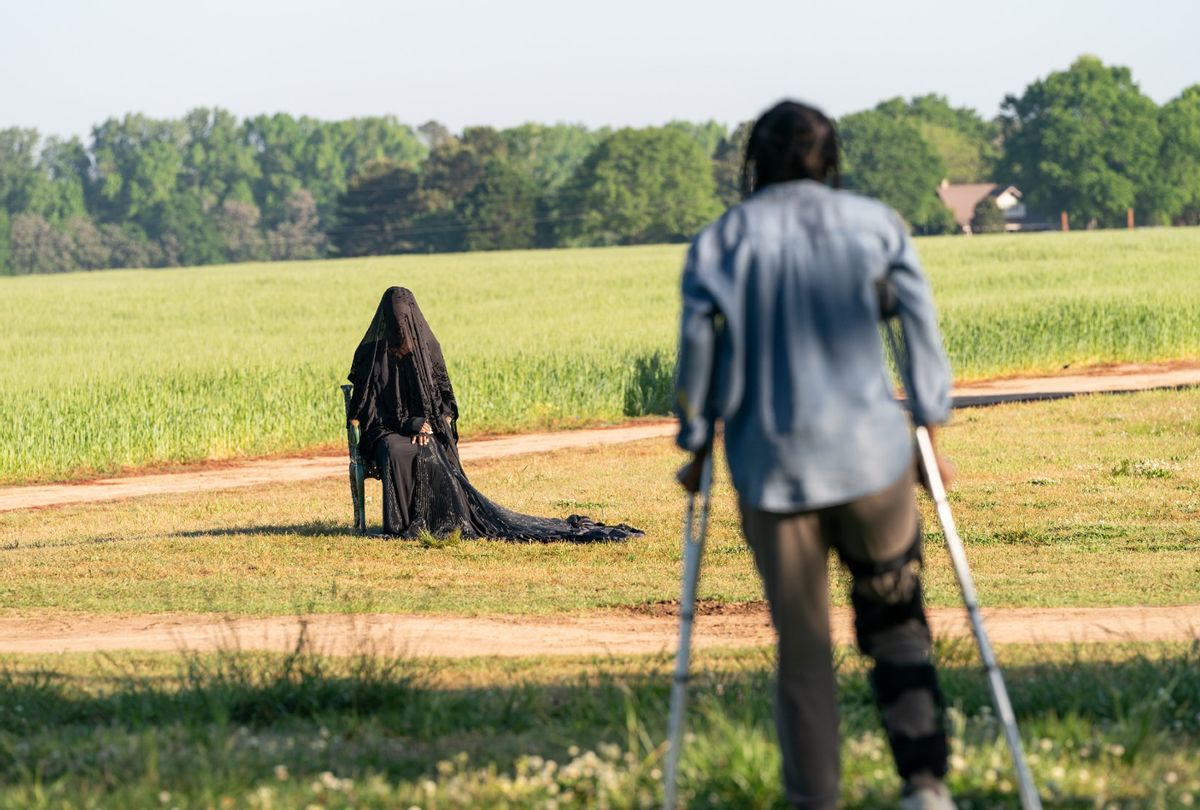Keep these traits in check the next time you find yourself in a horror film scenario: curiosity—the genre’s original sin—and dissatisfaction, its slipperier cousin. Corralling the former is as easy as ignoring the scraping sounds echoing from the basement and bolting the door shut. Whatever you think about doing when you hear something go bump in the night, don’t. That’s a surefire strategy for surviving horror, or at least outlasting everyone else.
Malcontentment is another matter. The heart wants what it wants, and people can’t help what they feel, but the sinister forces at the heart of all horror movies — man, manmade, natural or eldritch — have a dreadful knack for clocking existential malaise and reacting accordingly. In Danny and Michael Philippou’s 2022 smash hit "Talk to Me," for example, a grieving teenager reaches beyond death’s veil to communicate with her dead mother’s ghost; instead, she’s gulled by a cruel, duplicitous entity that cosplays as her mom and exploits her despair so thoroughly, it almost persuades her to roll her best friend’s little brother into traffic.
That’s called “effing around and finding out” in the parlance of our times; a succinct, coarse way to sum up one of horror cinema’s traditional functions. On Friday, director Jaume Collet-Serra and writer Sam Stefanak kept that tradition going with "The Woman in the Yard," the latest addition to Blumhouse Productions’ repertoire of contemporary campfire stories. The movie embraces the get-what-you-ask-for dynamic, centering on a fractured family – Ramona (Danielle Deadwyler), her son Taylor (Peyton Jackson), and her daughter Annie (Estella Kahiha) – still recovering from the sudden and recent loss of David (Russell Hornsby), her husband and their dad.
It’s a gorgeous day on their homestead: the sun’s beaming down on the field, the barn, the chicken coop and the black-garbed mystery woman (Okwui Okpokwasili) patiently sitting on an ornate chair between the fork in the dirt road. The woman appears out of nowhere with elusive purpose, taunting Ramona — who is hobbled by the broken leg she sustained in the car wreck that took David's life — warning, “Today’s the day,” in wicked sing-song. How well Ramona understands the woman’s meaning is an open question, but given that she limps off immediately on hearing the threat, “well enough” seems a reasonable estimation.
Want a daily wrap-up of all the news and commentary Salon has to offer? Subscribe to our morning newsletter, Crash Course.
"The Woman in the Yard" dissolves into a mess right after. Ramona is emotionally distant and prone to fearsome outbursts, notably berating Annie for repeatedly miswriting her “r”s on her homework. Meanwhile, as the family stays locked down in the house, the woman (and her exquisite chair) moves closer, foot by foot, toward their doorstep. Her shadow interacts with the physical world, too, making wind chimes whistle with a wag of her fingers — a deliciously spooky detail the movie doesn’t make enough hay out of. "The Woman in the Yard" much too coyly invites the audience to wonder whether the woman, or Ramona, is the greater danger; like too many modern horror films, it’s about trauma, actually, where the monster is an ancillary villain and the lead’s mental wellbeing is the true antagonist.
A second of longing is all it takes for evil to seep into the cracks of your life’s foundation.
Collet-Serra knots that thread with a third-act scene of unexpected tenderness, where Ramona and the woman do what people and monsters so rarely do: talk. “I don’t come unless I’m called,” the woman explains to Ramona, as Okpokwasili cuts a regal, gothic figure of steely poise, practically engulfing Deadwyler merely by sitting beside her. For a minute, the film seems to invoke Samuel Coleridge: “Death came with friendly care.” It turns out that Ramona unwittingly summoned the woman the night David died. A flashback shows the pair arguing over their living situation; he’s enthusiastic about relocating the family to the farmhouse, and she’s preemptively suffocating from seclusion’s effects on her work as an artist. On the drive home, Ramona catches the woman’s notice without realizing it, then loses control of the car.
 Ramona (Danielle Deadwyler), Annie (Estella Kahiha) and Taylor (Peyton Jackson) in "The Woman in the Yard" (Daniel Delgado Jr. / Universal Pictures)Cut to "The Woman in the Yard"’s present, when the woman has come to collect whatever debt she’s owed per Ramona’s accidental plea to her. Whatever Ramona wanted in the car, she’s experiencing ontological buyer’s remorse in the now. But that’s classic horror: a second of longing is all it takes for evil to seep into the cracks of your life’s foundation. It doesn’t matter how fast you come to your senses and put away those selfish desires. You effed around, and now you’re finding out, a sentence that bleeds into horror’s other function as a gauge for measuring the anxieties that weigh heaviest on our cultural consciousness. Horror films have a way of knowing what frightens people on a social scale, even before we do. What "The Woman in the Yard" lacks in cohesion, it makes up for as a bridge connecting genre with current events.
Ramona (Danielle Deadwyler), Annie (Estella Kahiha) and Taylor (Peyton Jackson) in "The Woman in the Yard" (Daniel Delgado Jr. / Universal Pictures)Cut to "The Woman in the Yard"’s present, when the woman has come to collect whatever debt she’s owed per Ramona’s accidental plea to her. Whatever Ramona wanted in the car, she’s experiencing ontological buyer’s remorse in the now. But that’s classic horror: a second of longing is all it takes for evil to seep into the cracks of your life’s foundation. It doesn’t matter how fast you come to your senses and put away those selfish desires. You effed around, and now you’re finding out, a sentence that bleeds into horror’s other function as a gauge for measuring the anxieties that weigh heaviest on our cultural consciousness. Horror films have a way of knowing what frightens people on a social scale, even before we do. What "The Woman in the Yard" lacks in cohesion, it makes up for as a bridge connecting genre with current events.
Horror films have a way of knowing what frightens people on a social scale, even before we do.
America’s writing a new, alarming, and astronomically stupid chapter on fascism and schadenfreude, having recently made the collective decision to re-elect Donald Trump to the highest office in the land; we made it through the first four years, after all, and the last four weren’t much better, so what’s the worst that could happen? Roughly 220,000 lost jobs later, with roughly 62,000 of those being government jobs slashed by a cohort of unelected Rand McPherson cosplayers, “the worst” looks catastrophic, and that’s not accounting for a sobering rash of black bagging incidents, a “brain drain” on the horizon as our bright scientific minds consider moving to Europe and imminent inflation spikes consequential to a brewing trade war with our longtime archnemesis, Canada.
 Okwui Okpokwasili as the Woman in "The Woman in the Yard" (Daniel Delgado Jr./Universal Pictures)If a reminder is necessary: people voted for this, another stay at the madhouse, knowing full well what the last stay was like and what fresh innovations Trump declared he had in store for the next one. It is little to no consolation, either, that the people responsible for inflicting the orange scourge on the red, white and blue with their votes again count among the number of Americans affected by this administration’s reckless ignorance — or who will be affected. Granted, there are folks out there giving Trump 2.0 a passing grade to date. But regretful voters exist, too. Some even feel as if they’ve been had. Whether or not developments like these will prove significant further down the road is uncertain.
Okwui Okpokwasili as the Woman in "The Woman in the Yard" (Daniel Delgado Jr./Universal Pictures)If a reminder is necessary: people voted for this, another stay at the madhouse, knowing full well what the last stay was like and what fresh innovations Trump declared he had in store for the next one. It is little to no consolation, either, that the people responsible for inflicting the orange scourge on the red, white and blue with their votes again count among the number of Americans affected by this administration’s reckless ignorance — or who will be affected. Granted, there are folks out there giving Trump 2.0 a passing grade to date. But regretful voters exist, too. Some even feel as if they’ve been had. Whether or not developments like these will prove significant further down the road is uncertain.
What is certain, for the time being, is that like Ramona, Trump’s voting public is paying a price for their indulgences. In the car, Ramona wanted the woman’s intervention; in the voting booth, an embarrassing number of American voters wanted Trump to shake up our standards and violate our norms. If Ramona could take back that car ride, most likely she would. If rueful MAGA junkies could go back to November 5, 2024, they might swap their vote or abstain altogether. "The Woman in the Yard" lives about as far from the American political zeitgeist as Ramona, Taylor and Annie do from civilization; distance notwithstanding, the film taps right into this moment of national guilt and despondency over choices made. It’s a moral lesson older than the movies, older than horror itself: Be careful what you wish for, and be careful what you vote for.



Shares